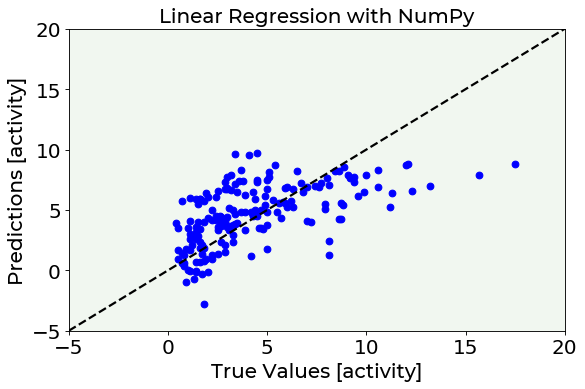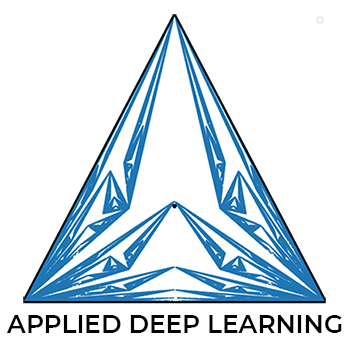Linear Regression with NumPy¶
Version 1.02
(C) 2020 - Umberto Michelucci, Michela Sperti
This notebook is part of the book Applied Deep Learning: a case based approach, 2nd edition from APRESS by U. Michelucci and M. Sperti.
The purpose of this notebook (that is intended to be analyzed in parallel with Linear_Regression_with_One_Neuron.ipynb) is to show a Linear Regression example performed with traditional math formulas and implemented with NumPy Python library.
Notebook Learning Goals¶
At the end of the notebook you are going to know every math detail behind linear regression. Moreover, you will have see an example of matrix operations in Python, performed with NumPy library. It is very useful to know this library, since it is the most famous and used package for scientific computing in Python.
Real Case Example: Radon Contamination¶
For this tutorial, we will use the same dataset already present in Linear_Regression_with_One_Neuron.ipynb notebook. The reason is to compare the two final results in order to demonstrate that neural networks can easily solve a traditional linear regression problem, with a very simple architecture. Therefore, keep in mind what you have learnt in Linear_Regression_with_One_Neuron.ipynb.
Theory behind Linear Regression¶
The formula to be implemented is the following:
where in our radon contamination regression problem, \(X\) is the matrix of features and \(Y\) is the column of corresponding labels.
Derivation
Let’s now derive the formula analytically. Since this is a linear regression problem, the function we want to minimize is defined as the Mean Square Error (MSE):
where \(x_i\) are the measurements and \(y_i\) are the correspondent target measurements. \(n\) is the total number of observations at our disposal and \(p_i\) are the coefficients we want to determine.
We will show the derivation in one dimension for simplicity, but the process is very easily expanded to many dimensions.
Let’s define:
To minimize the MSE we need to find the best \(\mathbf{p} = (p_0, p_1)\) that solve the equations
Let’s also define
where
so that
With this notation we can write
Note that the following is valid (you can easily check)
So we can write the MSE in matrix form as
and therefore
To find the best parameters we can neglect the \(1/n\) factor. Performing the multiplication of the matrices we find (you must be careful when multiplying them)
since is easy to verify that
At this point, using rules to evaluate derivatives of matrices we have
and solving for \(\mathbf{p}\) we get
and taking the transpose of both sides
note that \((A^{-1})^T = (A^T)^{-1}\) and therefore
since \((X^TX)^{-1} = X^TX\).
Numpy Implementation¶
Now the idea is to calculate the previously derived formula using NumPy operations between matrices.
Libraries and Dataset Import¶
The following lines will produce as ouput the radon dataset to which we will apply the regression model. You can just execute them, since we have already analyzed the details in Linear_Regression_with_One_Neuron.ipynb notebook.
# general libraries
import os
import numpy as np
import matplotlib.pyplot as plt
import matplotlib.font_manager as fm
# Referring to the following cell, if you want to re-clone a repository
# inside the google colab instance, you need to delete it first.
# You can delete the repositories contained in this instance executing
# the following two lines of code (deleting the # comment symbol).
# !rm -rf ADL-Book-2nd-Ed
# This command actually clone the repository of the book in the google colab
# instance. In this way this notebook will have access to the modules
# we have written for this book.
# Please note that in case you have already run this cell, and you run it again
# you may get the error message:
#
# fatal: destination path 'ADL-Book-2nd-Ed' already exists and is not an empty directory.
#
# In this case you can safely ignore the error message.
!git clone https://github.com/toelt-llc/ADL-Book-2nd-Ed.git
Cloning into 'ADL-Book-2nd-Ed'...
remote: Enumerating objects: 16, done.
remote: Counting objects: 100% (16/16), done.
remote: Compressing objects: 100% (10/10), done.
remote: Total 849 (delta 9), reused 13 (delta 6), pack-reused 833
Receiving objects: 100% (849/849), 60.20 MiB | 38.58 MiB/s, done.
Resolving deltas: 100% (403/403), done.
# This cell imports some custom written functions that we have created to
# make the loading of the data and the plotting easier. You don't need
# to undertsand the details and you can simply ignore this cell.
# Simply run it with CMD+Enter (on Mac) or CTRL+Enter (Windows or Ubuntu) to
# import the necessary functions.
import sys
sys.path.append('ADL-Book-2nd-Ed/modules/')
from read_radon_dataset import read_data
from style_setting import set_style
# This cell provides the dataset on which you will implement the linear regression model.
# Data are temporarily put into "tmp" folder. "url_base" contains the link to access the dataset.
# After cell's execution, you will have a variable containing features ("radon_features"),
# a variable containing labels ("radon_labels") and an informative variable containing
# all countries including in the dataset.
# You don't need to understand the implementation's details and you can simply ignore this cell.
# Simply run it with CMD+Enter (on Mac) or CTRL+Enter (Windows or Ubuntu) to
# import the necessary functions.
# inputs to download the dataset
CACHE_DIR = os.path.join(os.sep, 'tmp', 'radon')
url_base = 'http://www.stat.columbia.edu/~gelman/arm/examples/radon/'
# Alternative source:
# url_base = ('https://raw.githubusercontent.com/pymc-devs/uq_chapter/master/reference/data/')
rd = read_data(CACHE_DIR, url_base)
radon_features, radon_labels, county_name = rd.create_dataset()
Downloading http://www.stat.columbia.edu/~gelman/arm/examples/radon/srrs2.dat to /tmp/radon/srrs2.dat.
Downloading http://www.stat.columbia.edu/~gelman/arm/examples/radon/cty.dat to /tmp/radon/cty.dat.
Dataset Splitting¶
The following lines will produce as output the training dataset and the testing dataset for model’s development, which are the same sets used in the example performed with one neuron, so that we can compare final results of both approaches. You can just execute the following cell, since we have already analyzed the details in Linear_Regression_with_One_Neuron.ipynb notebook.
np.random.seed(42)
rnd = np.random.rand(len(radon_features)) < 0.8
train_x = radon_features[rnd] # training dataset (features)
train_y = radon_labels[rnd] # training dataset (labels)
test_x = radon_features[~rnd] # testing dataset (features)
test_y = radon_labels[~rnd] # testing dataset (labels)
print('The training dataset dimensions are: ', train_x.shape)
print('The testing dataset dimensions are: ', test_x.shape)
The training dataset dimensions are: (733, 4)
The testing dataset dimensions are: (186, 4)
Regression Coefficients Computation¶
Notice that radon_features is \(X\) and radon_labels is \(Y\). Remember we want to calculate the linear regression coefficients:
# We convert our data into NumPy arrays since we will use NumPy operations
X_train = train_x.values
Y_train = train_y.values
X_test = test_x.values
X_T = np.transpose(X_train) # np.transpose returns the transpose of a matrix
# np.linalg.inv returns the inverse of a matric
# np.matmul returns the multiplication between two matrices
p = np.matmul(np.matmul(np.linalg.inv(np.matmul(X_T,X_train)),X_T),Y_train)
Easy, right? You had a proof of the power and easiness of use of NumPy library in the case of matrices’ operations. Now let’s have a look at p.
print(p)
[-0.82682133 0.01678125 5.79487471 -0.13826876]
These are the four regression coefficients that fully describe our linear regression model. You can compare these numbers with the ones obtained in the Linear_regression_with_one_neuron.ipynb notebook. Let’s try to predict some radon activities now.
Model’s Performances Evaluation¶
# The following line contains the path to fonts that are used to plot result in
# a uniform way.
f = set_style().set_general_style_parameters()
test_predictions = np.dot(X_test,p) # predict radon activities using the linear regression
# coefficients just calculated
# Predictions vs. True Values PLOT
fig = plt.figure()
ax = fig.add_subplot(111)
plt.scatter(test_y, test_predictions, marker = 'o', c = 'blue')
plt.plot([-5,20], [-5,20], color = 'black', ls = '--')
plt.ylabel('Predictions [activity]', fontproperties = fm.FontProperties(fname = f))
plt.xlabel('True Values [activity]', fontproperties = fm.FontProperties(fname = f))
plt.title('Linear Regression with NumPy', fontproperties = fm.FontProperties(fname = f))
plt.ylim(-5, 20)
plt.xlim(-5, 20)
plt.axis(True)
plt.show()

Further Readings¶
NumPy package
All documentation (with lots of tutorial and examples already implemented): https://numpy.org/doc/stable/
